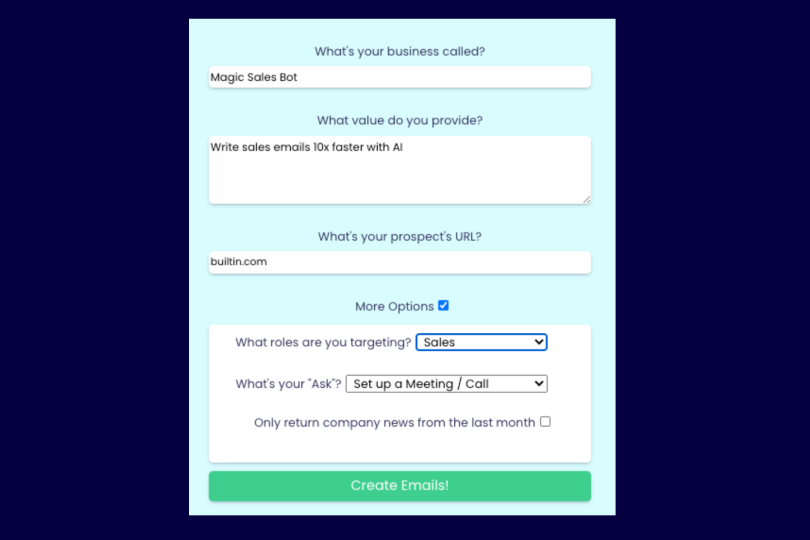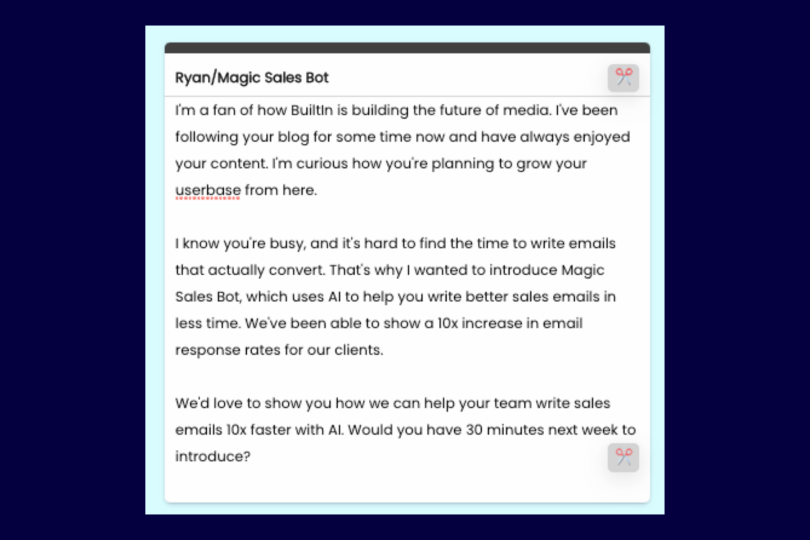Ryan Doyle had grown tired of a trend he saw in sales technology. Every tool seemed to focus on one thing — quantity. Send more emails, find more leads, make more phone calls.
Yet the best salespeople aren’t sending 1,000 emails a day. They’re spending their time researching prospects and crafting personal messages, said Doyle, who worked as a sales rep at the customer engagement platform Braze. So, he set out to build his own tool, one that would focus on quality outreach over quantity.
“We have a billion leads at our disposal, we can send a million emails a day, but we’re still not hitting our quotas. That struck a chord with me.”
This idea became the foundation for his custom tool, Magic Sales Bot, a program that automates building personalized sales emails.
“We have a billion leads at our disposal, we can send a million emails a day, but we’re still not hitting our quotas. That struck a chord with me,” Doyle said. “There are too many tools, and none of them do the job particularly well. There’s nothing that goes deep, that goes quality-focused.”
In order to make his vision a reality, Doyle first needed access to OpenAI’s language-generating API, GPT-3, an AI system that replicates human language. Of course, the way he got his hands on the cutting-edge software is itself a testament to the power of quality outreach.
Despite being placed on a 10-month waiting list and having no VC funding to back him, Doyle prospected OpenAI’s CTO with the most personalized campaign he could think of — a daily haiku. In mid-November, he sent his first poem on Twitter:
~ access for Ryan
~ OpenAI will then know
~ can a donkey code
That evening the CTO granted him access to the software, and Doyle went to work training it to write sales emails. In Magic Sales Bot’s current iteration, reps can enter their company information and who they’re prospecting, and the AI will generate five sales emails to choose from.
To make it work, Doyle had to crack the formula behind what makes an effective sales email. But he’s also wrestled with a challenging question. Personal sales emails stand out because of their human touch — will automation ruin that?
Ingredients of a Personalized Email
- Observation: Highlight the reason why you’re emailing the prospect now. This typically relates to a goal the prospect wants to accomplish.
- Challenge: Ask the prospect how the company plans to accomplish that goal.
- Pitch: Make your best offer for why your company can help this person reach the stated goal.
- Proof: Provide relevant customer case studies to back up your pitch.
- Keep It Simple: The email should be written at a fifth-grade reading level to make it quick and easy for the prospect to digest.
Training GPT-3 to Write Sales Emails
The first challenge Doyle faced in building Magic Sales Bot was figuring out how to train GPT-3 to write an effective sales email.
As a former sales rep, Doyle knew the best emails have two qualities — they are tied to a timely event, or what he calls an “opportunistic moment,” and they are tailored to the prospect. So, he focused on automating those two tasks.
“That idea of opportunistic moments is something that I tried to impart to younger sales reps — that’s true personalization.”
The research component proved to be the easiest. Opportunistic moments can be anything from a prospect earning a promotion to the company releasing its 10K report to a relevant news story, Doyle said. As a rep, Doyle would set up Google Alerts for his prospect companies, create custom LinkedIn searches for people earning promotions and changing jobs and visit Bloomberg News to find those noteworthy events.
That information would then form the foundation of his emails.
“That idea of opportunistic moments is something that I tried to impart to younger sales reps — that’s true personalization,” Doyle said. “It’s not just saying, ‘I see you went to this school’ ... it’s, ‘A news report came out that could impact your business.’ And you’re sending it with that context.”
Magic Sales Bot follows a similar process. Doyle set it up to pull company information and data from Clearbit. He then built a customized Google search engine that gathers information from a prospect’s LinkedIn profile and added a news API to return any recent alerts relevant to the company or industry.
The next step, however, was to tie that information into a human-sounding email. This proved to be trickier.
‘Create Me a Sales Email’
Doyle’s initial plan was to have the user upload their old sales emails to train GPT-3 to imitate their text. But because it also learned from other sales emails on the web, it didn’t know how to distinguish between a good email and a bad one.
“I was saying, ‘Create me a sales email,’ and it was like, ‘Hello, would you like to invest in our new product?’ It was like a game show host,” Doyle recalled. “It had consumed all of the sales emails on the internet, and it knew that sales emails sounded like that. They sounded corny, so it was giving me corny sales emails.”
Ultimately, Doyle realized that he’d need to break down each of his emails sentence by sentence to figure out what made them work. As he examined his old emails, he found that, while he wrote each one to be unique, they all followed a similar pattern.
“It had consumed all of the sales emails on the internet, and it knew that sales emails sounded like that. They sounded corny, so it was giving me corny sales emails.”
It starts with an observation about the prospect: “Hey, I saw your company is prioritizing customer experience in this 10K.” Then a challenge related to that observation: “How are you doing that as you scale up?” And then comes the pitch and the proof: “I ask because this is what my company is doing with competitor A and competitor B. We’ve not met with anyone from your company. We’d love to change that.”
He also discovered that the best emails were written at a fifth-grade reading level.
“You’re trying to capture [your prospect’s] attention in two or three seconds, and the more calories that they have to burn to understand what you’re trying to say, the less likely you are to get a response,” Doyle said. “So you need to make it caveman simple for them to understand what you’re trying to say.”
After spoon-feeding GPT-3 examples of the different components of a personalized email and tweaking it to be at a fifth-grade level, he started getting results that looked like real sales emails.
But does it actually work? Doyle shared a version of an email that he’d send to my company, Built In:


We showed that message to a member of our account management team who previously worked as an enterprise AE, and asked her for her thoughts. She admitted that she couldn’t tell it came from a bot, but she suggested the elements tailored to Built In could use some tweaking to be more accurate. (The lofty language about “building the future of media,” for example, earned a double-take, as it doesn’t quite capture Built In’s specific mission in the tech industry.)
While Doyle is continuing to make adjustments with GPT-3 to make the messages more accurate, this is also why his platform generates multiple email options and lets reps edit them. Nothing beats a human touch.
Human Eyes Required
After making Magic Sales Bot available to sales reps, one of the most common requests Doyle has received is to make it possible to create emails for hundreds of customers at once.
It’s a line he is hesitant to cross.
As it stands, Magic Sales Bot requires reps to build emails for one company at a time. For each one, the platform will generate five slightly different versions of an email. The user can then cut, paste and edit content from any of the emails to create a version that matches what they’re trying to communicate.
There’s a reason for that hands-on approach, Doyle said. He didn’t want to create another quantity-focused email generator that added more noise to inboxes. There are enough of those tools as it is, he added, and he believes it contributes to the bad rap salespeople get.
“In this quantity-focused paradigm that we’re in, salespeople have a bad reputation. They’re slimy, they don’t listen, and all these things that our prospects say about salespeople,” he said. “I didn’t want to contribute to that poor view of a salesperson.”
The hands-on component requires the rep to slow down and take some responsibility for the quality of the email. It’s like adding an egg to an instant cake mix, he said. While the platform is doing most of the work, it still requires a sales rep to add their touch.
“When you can start to automate away these emails or activities that we all have to do, you can spend time on those above-and-beyond activities.”
Ultimately, Doyle’s goal was to automate the time-consuming tasks that prevent reps from sending personalized emails in the first place. His hope is that, in doing so, it will free reps up to spend more time on creative prospecting endeavors, like creating video messages or direct-mail campaigns.
Those human touches, coupled with personalized emails, are what truly help a sales rep stand out from the crowd.
“When you can start to automate away these emails or activities that we all have to do, you can spend time on those above-and-beyond activities,” Doyle said. “What’s something creative you can try?”




